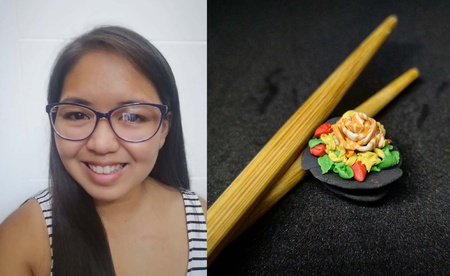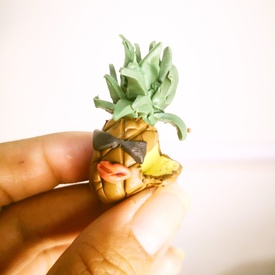When playing with her partner's daughter, Luciana Yamashiro noticed that her dolls must be tired of always having to eat bread and pizza, plus an occasional banana, and no Peruvian food. Then it occurred to him that they could make dishes with plasticine. He's told it before in a few interviews, but every time he repeats the anecdote he seems happy to be telling a good prank.

This is how “ Plasticina Feliz, Mini clayfood ” was born, the name of the Instagram account that he created in 2018 to publish the photos of the mini hamburger, the miniature fried egg and the huancaína potato, with a tiny portion, which motivated this Nikkei industrial designer to continue kneading the plasticines to give shape and color to ice cream, churros and even salmon sashimi that look as real as they are appetizing.
“The name Plastilina Feliz goes to the objective of the project, food makes us happy and through it we can reach the culture of a place, even if it is with a fried egg, which represents something about you, how your mother prepared it for you and being children again," says Luciana, 32 years old and such a young soul that she still has fun like a child making donuts, nigiris , temakis and miniature plasticine macaroni, as well as classic Peruvian dishes such as lomo saltado, causa and ceviche. with chicharrón
Mind at play
Being children again does not seem like a bad plan in this pandemic situation without the possibility of traveling, attending social gatherings or other places of entertainment. For Luciana, like everyone else, it was difficult at first, but she got used to it as she began to study astrology (“it helped me understand many internal processes”) and launched the brand Akame Dim Sum , of steamed Asian snacks.

“I make them myself, it was a venture that was born in the pandemic, being at home, with more time to cook and try things. I made hamburgers, cookies, desserts and dumplings,” says Luciana, who has a Chinese great-grandmother and who says that, at her school, Juan XXIII, she had a great contact with the Chinese colony in Peru. “On YouTube I found how to make the dough and the filling, I did some tests at home and they liked them.”
In November 2020, the Alpha school supplies brand contacted her to teach crafts with plasticine classes and she was delighted to accept, knowing what a challenge it could be to teach through a video camera. “There are kids who are no older than 11 years old and you can see their talent when they send me photos of their work,” says Luciana, who this year started another virtual course with the Peruvian-Japanese Association, once a week, as part of the program. Omoshiroi of the Peruvian Japanese Cultural Center.
Create and activate

Many adults follow Luciana's work and virtual classes. “I ask friends who connect to show me what they have done, but many only do it to see or have something to be with.” One of his discoveries with plasticine has been to understand that, through creation and hand movement, the brain activates and expresses itself.
"The important thing is manipulation, doing manual things has a positive effect on mental health, and representing something in an artistic form is connecting with the environment, leaving the self to become sensitive and become more empathetic with what is outside of me "It's what I take away from what I see in classes," says Luciana, who was always interested in exploring the children's universe. “There are fewer trials. At university one thinks that in the art department everything is freedom, but it is very demanding. I thought it looked good, but the faculty professors were experts.”
That experience at the Pontifical Catholic University of Peru has served him well, as has teaching classes at the Toulouse Lautrec Institute. “You don't have to tell children 'not like that' or 'you were wrong', it's about finding themselves. Everything we do is going to be a reflection of us,” says Yamashiro, who hopes to continue making videos for different social networks and teaching classes for children and adults, like her mother, who follows her from the United States.
Plasticine lessons
Luciana says that she uses little material in her creations because they are miniature, that she has learned to use those made of water and those made of fat, and that sometimes she recommends using polymer clay, which is less fragile and can be baked in an oven. homemade, for the works that you want to keep. But, without a doubt, the main thing is to find the color of what you want to reproduce, since the brands available in stores offer a range of options and sometimes you have to find different tones, such as the green of the green noodles that it has. on his Instagram account.
"One of the exercises I did when I was a teacher is to make them look around to recognize the objects we have and think if they have been designed based on knowledge of the human body and its needs." In this way, plasticine becomes an exercise in observation and understanding of space. In addition, Luciana says, virtual classes have allowed her to identify other values that add to this manual art. “In the videos you can only see the face and up to the shoulders, the remote experience is a challenge for the kids to express themselves better and in a short time.”
She says that one of her references is the Japanese educational program “Can I do it?”, by Nopo and Gonta , which was broadcast in the eighties and nineties, and which has led her to use homemade materials (a paperclip, a spoon or a butter knife) instead of certain instruments that can be dangerous to children. “The main thing was to have fun, that's what we were looking for, to experiment with clay, they are not art classes,” says Luciana Yamashiro, who plans an upcoming Zoom course to continue being happy with clay.

Nikkei family
Her menu of plasticine creations includes a salchipapa, a panettone, a tacacho with cecina (a dish from the Peruvian jungle), makis and chaufa rice, a sample of the diversity of Peruvian cuisine, something that is in her blood. “In my family and in the Nikkei community it is customary to bring a dessert to gatherings and share food. My husband had a hard time getting used to it at first,” says Luciana, who used to attend meetings of the Okinawan Association of Peru.
He also participated in Nikkei interclub events and singing competitions organized by the community. His artistic vein was always present, even when he dedicated himself to working in advertising and marketing, designing furniture for 3D advertisements for retail stores. “I didn't study sculpture because I didn't know what I could make a living from, but I have always done work that has to do with the volumetric. I feel that everything contributes to me.”
Among his plans is to create his website and be able to dedicate himself mainly to clay. He has more and more clients asking for souvenirs in this material and the advantage is that it is a job that can continue remotely and have time for other activities. “In Japan I have a lot of family, I recently met an aunt from Okinawa who I talked to, and my parents live in the United States with my brother,” says Luciana, who continues to amass fun projects (“some pizza-shaped earrings, maybe ").
© 2021 Javier García Wong-Kit





